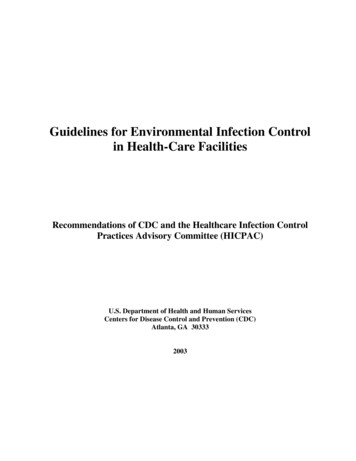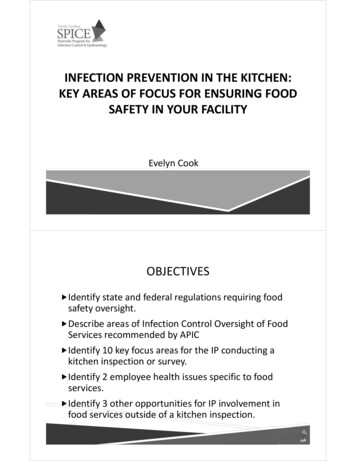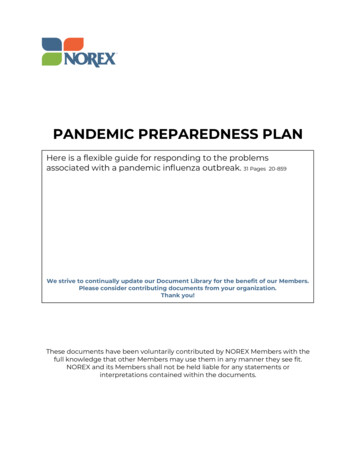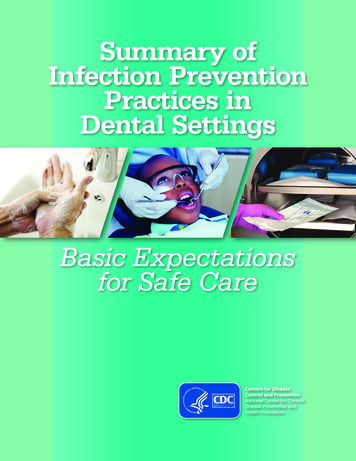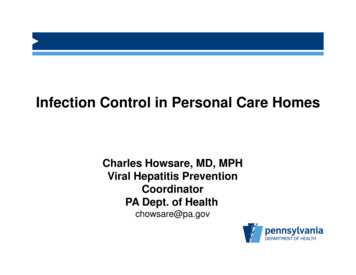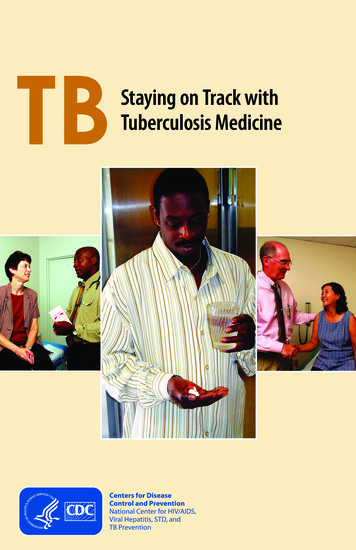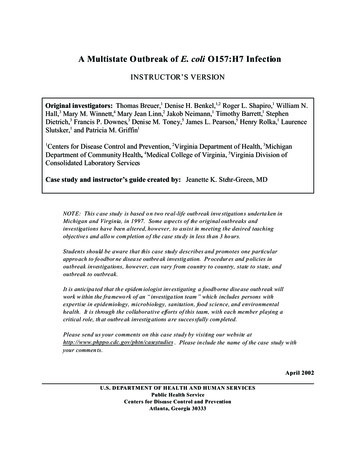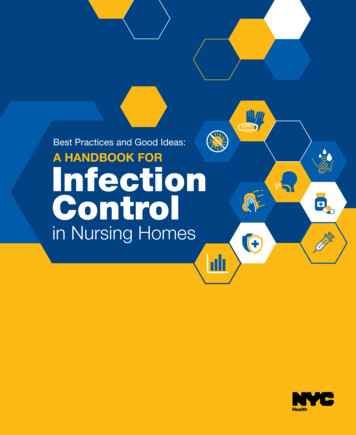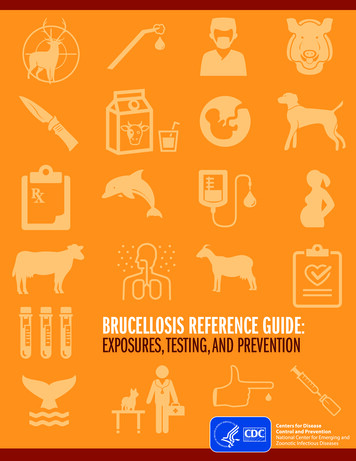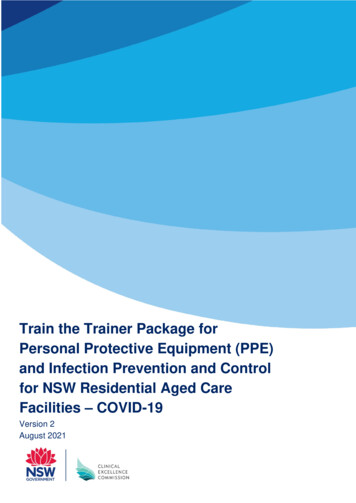
Transcription
Train the Trainer Package forPersonal Protective Equipment (PPE)and Infection Prevention and Controlfor NSW Residential Aged CareFacilities – COVID-19Version 2August 2021Name of DocumentVersionPage 1 of 27
ContentsIntroduction .3Infection Prevention and Control .3Key Infection Prevention and Control Resources and Guidance . 4Escalation and Response – geographical areas .4Education and Training Infection Prevention and Control . 5Train the Trainer Model .51. Clinical Excellence Commission (or Local Health District) PPE Training Session Plan for AgedCareTrainers.5Choosing an LHD trainer to provide the ‘train the trainer’ package . 62.PPE Training Session Plan for RACF Trainers . 7Training Resources.9Online Infection control training and education for RACF staff . 9Infection Prevention and Control Precautions .9Training: Standard Precautions.9Training: Transmission Based Precautions .14Contact precautions.14Droplet precautions .16Airborne precautions .17Combined Precautions .19Combined Contact and Droplet Precautions .19Video: Combined contact and droplet precautions . 21Combined Contact, Droplet and Airborne Precautions . 21Video: Combined contact, droplet and airborne precautions . 22Appendix A - Support Material .22Appendix B - Session Plan: PPE sizing, donning and doffing demonstration and practice . 27Train the Trainer – Residential Aged CareVersion 2.0, August 2021UNCONTROLLED WHEN PRINTEDPage 2 of 27
IntroductionResidential aged care (RAC) is an essential service for older people, some younger people with complexhealth conditions and people with disabilities who can no longer live at home and who need help witheveryday tasks or health care.Residential Aged Care Facilities (RACFs) are at risk of outbreaks due to the complexity of the residents,shared spaces/activities and limited access to infection prevention and control education. A solid andpractical infection prevention and control program, with a focused understanding of personal protectiveequipment (PPE) and its application is particularly important for the management and control of COVID19 outbreaks.The following resource provides a train the trainer package to be implemented to NSW RACFs tofacilitate their understanding in infection prevention and control and PPE as it applies to COVID-19.This resource does not replace the requirements for RACF to meet the national standards as set out bythe Aged Care Quality and Safety Commission and should be used to support and enhance existingprograms and strategies.NSW Health and the Commonwealth Department of Health have formalised the coordination ofgovernment support to residential aged care providers in their management of a COVID-19 outbreak.The protocol incorporates feedback received during consultation sessions with aged care peak bodiesand providers.The roles and responsibilities of all relevant parties, governance structures and escalation proceduresare outlined with the intention that the protocol facilitates fast mobilisation of required governmentsupport to an aged care provider in the event of a COVID-19 outbreak.The primary objectives of the protocol are to optimise care for all residents in impacted RACFs(regardless of their COVID-19 status) and to contain and control an outbreak to bring it to an end asquickly and safely as possible.Governance and escalation are a critical component to manage the identification, management,education and communication, of potential and confirmed, COVID-19 outbreaks in RACFs.Infection Prevention and ControlInfection Prevention and Control (IPAC) refers to evidence-based practices and procedures that, whenapplied consistently in healthcare settings, can prevent or reduce the risk of transmission ofcommunicable diseases and transmissible infections to aged care providers, staff, residents and visitors.Staff within RACFs will be required to understand when an outbreak for COVID-19 is declared, that theyfeel confident of their ability to understand the Personal Protection Equipment (PPE) requirements, whento wear PPE, when to change PPE elements and how to remove PPE safely.All PPE should be used in line with the principles in the Australian Guidelines for the Prevention andControl of Infection in Healthcare (2019), whilst acknowledging the unique circumstance of COVID-19.Train the Trainer – Residential Aged CareVersion 2.0, August 2021UNCONTROLLED WHEN PRINTEDPage 3 of 27
Key Infection Prevention and Control Resources and GuidanceAustralian Guidelines for the Prevention and Control of Infection in Healthcare (2019)CEC Infection Control Policy and GuidelinesCEC COVID-19 infection prevention and control guidanceCoronavirus (COVID-19) guidelines for infection prevention and control in residential care facilities.National GuidelinesAustralian Health Protection Principle Committee (AHPPC) update to residential Aged Care facilitiesabout minimising the impact of COVID-19, RACF Visitor guidelinesCoronavirus (COVID-19) Environmental cleaning and disinfection principles for health and residentialcare facilitiesCOVID-19 Infection Prevention and Control Manual and CEC Respiratory Protection in HealthcareEscalation and Response – geographical areasIn geographical areas with significant community transmission of COVID-19 (as defined by jurisdictionalpublic health units), in specified aged care settings, and aged care staff 1 may need to take extraprecautions. This may include precautions above those usually indicated for standard and transmissionbased precautions. For more in depth information see Coronavirus (COVID-19) guidelines for infectionprevention and control in residential care facilities.Within New South Wales (NSW), during situations of increased risk, it is important to be able to escalatethe IPAC precautions to align with the risk of community transmission and onward spread. Risk maychange based on numbers and geographical locations of spread. Changes to risk of COVID-19 will bebased on NSW Health changing the Response and Escalation Framework for NSW. This should bechecked before any changes are made to PPE use outside of standard and transmission-basedprecautions.Within RACFs, decisions to change existing COVID-19 prevention strategies will be directed from NSWHealth, Commonwealth Department of Health or RACF owner/operators.1Includes aged care staff, personal care workers and support staff who have direct contact with residents or residents in healthand residential care facilities, where the risk of COVID-19 transmission is judged to be significant.Train the Trainer – Residential Aged CareVersion 2.0, August 2021UNCONTROLLED WHEN PRINTEDPage 4 of 27
Education and Training Infection Prevention and ControlTrain the Trainer Model1. Clinical Excellence Commission (or Local Health District) PPE Training SessionPlan for Aged CareTrainersLearning Objective Participants will be able to explain why PPE is necessary in reducing the risk of transmission ofCOVID-19Participants will be able to identify correct PPE required in the residential aged care settingParticipants will be able to demonstrate the correct donning and doffing of PPE to enable trainingof staffLearning Outcomes Identify the PPE available for staff within RACFUnderstand the importance of PPEUnderstand previous infectious disease outbreaks and relate that to the importance of correctPPE useIdentify the PPE required foro Standard precautionso Transmission-Based Precautions Contact precautions Droplet precautions Airborne Precautions Combined Precautions: Contact and Droplet Combined Precautions: Contact, Airborne and DropletAssessment criteria Staff will demonstrate correct technique for donning and doffing PPEResources and training aids required PowerPoint presentation- use note section on presentation to guide youPPE competencies (donning and doffing)Hand hygiene productDetergent wipes for reusable protective eyewearWaste receptacle/bagsP2/N95 respirator competency- fit checkPPE for each staff memberooooooGlovesImpervious gown or apronFluid repellent surgical maskP2/ N95 respiratorSurgical maskEye protectionTrain the Trainer – Residential Aged CareVersion 2.0, August 2021UNCONTROLLED WHEN PRINTEDPage 5 of 27
Session planTOPICS TO BE COVEREDTIME FRAME FOR 5STAFF MEMBERSIntroductionOverview of the session15 minutesPresent PowerPoint presentation (PPT)90 minutesDonning and doffing PPE competency toolP2/ N95 respirator - fit check competencyTrainer to demonstrate sequence to staff2 hoursDiscussion and questions90 minutesHow to use the training package provided:o Scenarios/workshops and videoso Support materials available e.g. posterso When is PPE required within RACFs?o The correct PPE to be used60 minutesOutcome of training sessionParticipants will be able toooDemonstrate the correct sequence in donning and doffing of PPE and achieve an understandingon the importance of PPE in the RACF to prevent cross transmission of organism.Demonstrate an ability to train others in safe donning and doffing of PPERecord of training: Record ALL staff completing this education/competency sessionChoosing an LHD trainer to provide the ‘train the trainer’ packageThe following criteria may assist each LHD to determine who should be able to provide the training toRACFs within the LHD. The following criteria is a guide only: Experienced IPAC CNC – (meet the criteria for a CNC grade) or IPAC with aged care experienceProvided education workshops to groupso Understands how to translate IPAC principles from acute care to RACFo Understands skill and staffing levels with RACFso Understands RACF – resident’s home environment with lots of social interaction – not ahospital environmento Able to use appropriate language for RACF e.g. residents, not patientso Able to present, demonstrate PPE and assess donning and doffing PPE Able to respond to some of the difficult questions that may arise during the training sessiono PPE may frighten residents; how do we discuss this with our residents?o What PPE can be worn for a sessional period?o What PPE requires changing in the resident’s room if performing multiple tasks?o Do we need to wear gloves if we hold a resident’s hand?Train the Trainer – Residential Aged CareVersion 2.0, August 2021UNCONTROLLED WHEN PRINTEDPage 6 of 27
2. PPE Training Session Plan for RACF TrainersTraining of staff within each RACF will vary, depending on previous infection prevention and controltraining and education. The sessions can range from presentations, scenario workshops, watchingvideos and practising donning/doffing PPE.Suggested presentations and practice sessions:Overview of coronavirus, SARS-CoV-2 and COVID-19How is COVID-19 transmitted?How droplets and aerosols spread?How do we transmit COVID-19?How do we break the chain of infection?What are standard precautions?What is transmission-based precautions?Combining precautions - videosRespiratory protection: P2/N95 respiratorsFit checking - videosPracticing donning/doffing PPEPracticing donning/fit checking/doffing P2/N95 respirators30 minutes30 minutes45 minutes20-30 minutes60 minutes45 minutesTrain the Trainer – Residential Aged CareVersion 2.0, August 2021UNCONTROLLED WHEN PRINTEDPage 7 of 27
Competency Assessment for donning/doffing PPESee Session Plan: PPE sizing, donning and doffing demonstration and practiceSuggestions for short in-service sessions:Key practice points for standard precautions:Suggested topicHand HygieneRespiratory Hygiene (Cough Etiquette)Personal Protective Equipment (PPE)Aseptic TechniqueNeedle-stick and Sharps Injury PreventionCleaning and DisinfectionWaste DisposalLinen managementSession PlanBreak into smaller groups of 2-3 participantsWrite down responses to the questionsAll groups present their discussion responsesDiscuss other options or practices that need to be consideredKey practice points for contact precautions:Suggested topicAs per scenarioSession PlanBreak into smaller groups of 2-3 staff membersWrite down responses to the questionsAll groups present their discussion responsesDiscuss other options or practices that need to be consideredKey practice points for droplet precautions:Suggested topicAs per scenarioSession PlanBreak into smaller groups of 2-3 staff membersWrite down responses to the questionsAll groups present their discussion responsesDiscuss other options or practices that need to be consideredKey practice points for airborne precautions:Suggested topicAs per scenarioSuggested session timeframe30 minutes30 minutes30 – 45 minutes30 – 45 minutes20 minutes30 – 45 minutes20 minutes20 minutesSuggested session timeframe30 – 45 minutesInclude watching the videoSuggested session timeframe30 – 45 minutesInclude watching the videoSuggested session timeframe30 – 45 minutesInclude watching the videoSession PlanBreak into smaller groups of 2-3 staff membersWrite down responses to the questionsAll groups present their discussion responsesDiscuss other options or practices that need to be consideredTrain the Trainer – Residential Aged CareVersion 2.0, August 2021UNCONTROLLED WHEN PRINTEDPage 8 of 27
Training ResourcesOnline Infection control training and education for RACF staff1. Autralian Commission Quality and Safety In healthcare elearning modules Infection Preventionand Controlo National Hand Hygiene Initiative, also includes infection prevention and control education(free)2. ACIPC – Basic Infection Prevention and Control (cost to complete course)3. ACIPC - Aged Care: Online short course in Infection Prevention and Controlin Aged CareSettings (cost to complete course)4. NSW Health managed RACF - Staff are encouraged to complete three My Health Learningmodules related to COVID-19, in addition to the new module titled "Personal protectiveequipment for combined transmission-based precautions".o Infection Prevention and Control Practices (Course code: 46777047) (free)o Infection Prevention – Transmission Based Precautions (Course code: 253093581) (free)o Infection Prevention – Enhanced Precautions for Pandemic Flu (Course code:289888589) (free)5. Clinical Excellence Commission - free education videos are available to view on the YouTubechannel. or they can be accessed on:o Combined contact, droplet and airborne precautions (COVID-19)o Transmission Based Precautions Contact Precautions Standard Precautions – donning PPE, interacting withpatients and doffing PPE Droplet Precautions Standard Precautions – donning PPE, interacting withpatients and doffing PPE Airborne Precautions Standard Precautions – donning PPE, interacting withpatients and doffing PPE Donning and fit checking P2 or N95 respirators (various brands)Trainers and education providers from RACFs should use these resources to continue training andassessment of the aged care workforce.Infection Prevention and Control PrecautionsKey training practice point:It is important that staff understand that there are several infection prevention and control strategies toprevent and control the transmission of COVID-19 and other communicable diseases within RACFs. Thefocus on COVID-19 specific PPE is required as it is unlike other PPE worn for RACF previouslyexperienced communicable disease outbreaks eg influenza, gastroenteritis. Existing evidence indicatesand reports from Victoria indicate that COVID-19 can be transmitted to aged care staff if PPE is notworn, removed or disposed of correctly.Training: Standard PrecautionsStandard Precautions represent the minimum infection prevention measures that apply to all resident’scare, regardless of suspected or confirmed infection status of the residents, in any setting wherehealthcare is delivered. These evidence-based practices are designed to both protect and preventspread of infection among residents and healthcare personnel.Train the Trainer – Residential Aged CareVersion 2.0, August 2021UNCONTROLLED WHEN PRINTEDPage 9 of 27
Standard Precautions comprise the following measures: Hand HygieneRespiratory Hygiene (Cough Etiquette)Personal Protective Equipment (PPE)Aseptic TechniqueNeedle-stick and Sharps Injury PreventionCleaning and DisinfectionWaste DisposalLinen managementKey practice points for standard precautions:Suggested inclusion in an education programSuggested scenario orworkshopFor information: see Infection Prevention and ControlPractice HandbookHand Hygiene (HH) – include these points into the trainingscenario Why is HH important to protect staff, residents and theenvironment/equipment Why is it important to use HH rather than gloves? Staff - when to perform hand hygiene when not incontact with residents e.g. going to the bathroom,eating, arrival to work, cleaning equipment Staff - when to perform hand hygiene when in contactwith residents e.g. 5 Moments of hand hygiene Resident hand hygiene e.g. before eating, beforeactivities, before going outside, before physiotherapyor activities Visitor hand hygiene e.g. before entering, before andafter touching the resident Include duration of HH Products to use for HH, including any particular handwipes for residents Location of HH products What to do if HH products are empty What to do if you have a reaction to a HH product Why should staff be bare below the elbow?How to teach residents to cover their nose and mouthwhen coughing and sneezingThey require a daily dressing toan arm wound, sustained in a fall.Family members are anxious tovisitThe resident is very outgoing andwants to participate in ‘allactivities’Workshop: what education will berequired for staff, the residentand family members on HH?Handbook Reference: 4.1 HandhygieneRespiratory Hygiene (Cough Etiquette) – include these pointsinto the training scenario A new resident is admitted, andthey require an orientation to theRACF.Workshop:1. what would you provide to aresident who has commoncold symptoms? How wouldTrain the Trainer – Residential Aged CareVersion 2.0, August 2021UNCONTROLLED WHEN PRINTEDPage 10 of 27
Key practice points for standard precautions:Suggested inclusion in an education programSuggested scenario orworkshopFor information: see Infection Prevention and ControlPractice Handbook Disposing of tissues immediately after use Performing HH after touching nose/mouth Staff who have acute respiratory illness symptoms –why they are unable to come to work? What will happen to staff who become unwell duringwork hours Why visitors with acute respiratory symptoms shouldnot enter a RACF unless they have been reviewed bythe in-charge, determined to be COVID-19 andcommunicable disease negative and a mask is to beworn (special circumstances such as end of life)you provide reminders to theresident?2. how would you know if it wasa common cold or COVID19?3. Who would this be reportedto? How quickly should youreport it?Handbook Reference: 4.2Respiratory Hygiene and coughetiquetteWorkshop: A resident who hasAlzheimer’s, is aggressive attimes (unpredictable) and isincontinent. The residentbecomes very frightened if staffwear a yellow gown. What PPEwould be required whenshowering the resident?Personal Protective Equipment (PPE) – include these pointsinto the training scenario PPE is required to protect staff from contact withblood or body fluids. Performing a risk assessment to determine what PPEis required when performing care or a procedure on aresidentHandbook Reference: 4, 4.3 PPEAseptic Technique – include these points into the trainingscenario What is aseptic technique? When would aseptic technique be used? How would a procedure be performed using aseptictechnique?Workshop: A resident requires adaily wound dressing. How willthis be performed using anaseptic technique?Handbook Reference: 4.4 AseptictechniqueNeedle-stick and Sharps Injury Prevention – include thesepoints into the training scenarioWorkshop: staff member jabstheir finger with an insulin needle.What do they need to doimmediately? Who should theyreport to? What follow up do theyrequire? What is a sharps injury? What is a blood or body fluid splash? What first aid should be performed? What are the risks of a bloodborne virus transmission? How should these be prevented?Handbook Reference: 4.5Needlestick and sharps injurypreventionTrain the Trainer – Residential Aged CareVersion 2.0, August 2021UNCONTROLLED WHEN PRINTEDPage 11 of 27
Key practice points for standard precautions:Suggested inclusion in an education programFor information: see Infection Prevention and ControlPractice HandbookCleaning and Disinfection – include these points into thetraining scenario Why is cleaning the environment important? How does it prevent transmission of COVID-19? What should you use to clean? Why is important to clean any shared equipment orshared activity equipment? What is the difference between a detergent and adisinfectant? When do you use a detergent? When is a disinfectant required? What is a frequent high touch point e.g. door handles,light switches, TV remote? How do we identify frequent high touch points forresidents, staff and visitors?Waste Disposal – include these points into the trainingscenario Why is it important to dispose of waste correctly? What types of waste within the RACF?Suggested scenario orworkshopWorkshop:1. Residents come togethercome together daily foractivities. They handlevarious shared equipmentand items. Choose 3 commonitems that residents shareand determine how theyshould be cleaned and storedafter use2. list 5 high touch points thatcould be classified aspotentially contaminated in aresident's roomHandbook Reference: 4.6Cleaning and disinfection, 4.8Environmental cleaningWorkshop: ideas for a recyclingprogramHandbook Reference: 4.9 wastemanagement Handling of waste safelyLinen Management – include these points into the trainingscenario Why is it important not to mix clean and dirty linenstorage?Workshop: how should be handlelinen if there is an outbreak?Handbook Reference: 4.7 CleanLinen How should line be stored? How should dirty linen be handled and carried by staff When should linen be placed in a fluid resistant bag?Train the Trainer – Residential Aged CareVersion 2.0, August 2021UNCONTROLLED WHEN PRINTEDPage 12 of 27
Key practice points: Respiratory Hygiene (Cough Etiquette) for staffDuring a pandemic, people with any acute respiratory symptoms must not enter a RACF.To minimise the risk of transmission of infection to others, everyone entering, visiting or working within aRACF presenting with the signs and symptoms of respiratory infection should practise respiratoryhygiene and cough etiquette. A RACF should encourage and enable residents, visitors and staff toperform respiratory hygiene and cough etiquette and provide appropriate resources to support thesebehaviours.The following measures to contain respiratory secretions are recommended for all individuals; Cover your mouth and nose with a tissue when coughing or sneezing; If you don't have a tissue, cough or sneeze into your elbow; Use the nearest waste receptacle to dispose of the tissue after use; Perform hand hygiene (e.g. hand washing with soap and water if hands are visibly soiled, oralcohol-based hand rub, after having contact with respiratory secretions and contaminatedobjects/materials.RACF should ensure the availability of materials for adhering to Respiratory Hygiene/Cough Etiquette inwaiting areas for residents and visitors. Provide tissues and no-touch receptacles for used tissue disposal. Provide conveniently located dispensers of alcohol-based hand rub; where sinks are available,ensure that supplies for hand washing (i.e. soap, disposable towels) are consistently available.Handbook References: click here1. Handbook Reference: 4.2 Respiratory Hygiene and cough etiquetteKey practice points: Personal Protective Equipment (PPE) – risk assessment for standardprecautionsAppropriate PPE should be selected to prevent contamination of skin and/or clothing. Selections shouldbe guided by the anticipated type and amount of exposure to blood and body substances and the likelytransmission route of microorganisms. Further information is available at ACSQHC.When you are selecting PPE, consider three key things; First is the type of anticipated exposure. This is determined by the type of activity, such as touch,splashes or sprays, or large volumes of blood or body substance that might penetrate theclothing. Second is the strength and suitability of the PPE for the task. This will affect, for example,whether a gown or apron is selected for PPE, or, if a gown is selected, whether it needs to befluid resistant, fluid proof, or neither. Third is fit. PPE must fit the individual user, and it is up to the employer to ensure that all PPEare available in sizes appropriate for the workforce that must be protected.Handbook References:2. 4.3 Personal Protective Equipment3. 5.5 Personal Protective Equipment RequirementsTrain the Trainer – Residential Aged CareVersion 2.0, August 2021UNCONTROLLED WHEN PRINTEDPage 13 of 27
Training: Transmission Based PrecautionsTransmission-Based Precautions should be used when standard precautions alone are not enough tostop the transmission of a communicable disease or a transmissible infection.It is also known how the communicable disease, or a transmissible infection is transmitted and what PPEis required to stop the spread to staff, the environment and to the resident.Transmission-Based Precautions are to be applied in addition to standard precautions. There are threetypes of Transmission-Based Precautions, tailored to the different types of transmission.Contact precautionsContact precautions, when used with standard precautions, are designed to reduce the risk oftransmission of microorganisms by direct and/or indirect contact.Perform a risk assessment based on residents' communicability or risk of transmitting infection to others,the RACF environment and to staff. This will guide decisions regarding what PPE is required, when ishand hygiene performed, when gloves should be worn and when PPE is removed.Contact precautions should be considered for residents colonised or infected with a multidrug-resistantorganism (MRO) where there is significant resident and/or environmental contact.Assessment of the resident’s risk factors that potentially contribute to the spread of organisms in additionto local epidemiology will guide clinicians to whether resident require contact precautions with isolation,cohorting or management using standard precautions.Contact precautions consist of:Before entering residents’ zone Perform hand hygienePreform a risk assessment on the need for apron/gown i.e. type of resident contact (contact withblood or a body substance), type of MRO (how and where it is transmitted from on the resident),residents’ status (wet or dry)After entering residents’ zone Perform hand hygienePerform a risk assessment on the need for gloves and what you will be in contact with whenproviding care, assistance or a procedure on the residentChange or remove glove (if worn) and perform hand hygiene in between dirty and clean tasks.Also change gloves and perform hand hygiene between different procedures on the resident egchanging a dressing and an incontinence pad.On leaving residents zone Remove and dispose gloves (if worn)Perform hand hygieneDispose apron/gown (if worn)Perform hand hygieneClean shared equipment (if used) and perform hand hygieneDispose of all waste and perform hand hygieneWhen transporting residents outside of the room, remove PPE and perform hand hygiene after placingresidents on trolley/stretcher/wheelchair.Use residents-dedicated or single-use non-critical residents-care equipment.Train the Trainer – Residential Aged CareVersion 2.0, August 2021UNCONTROLLED WHEN PRINTEDPage 14 of 27
Ensure consistent cleaning and disin
practical infection prevention and control program, with a focused understanding of personal protective equipment (PPE) and its application is particularly important for the management and control of COVID-19 outbreaks. The following resource provides a train the t
